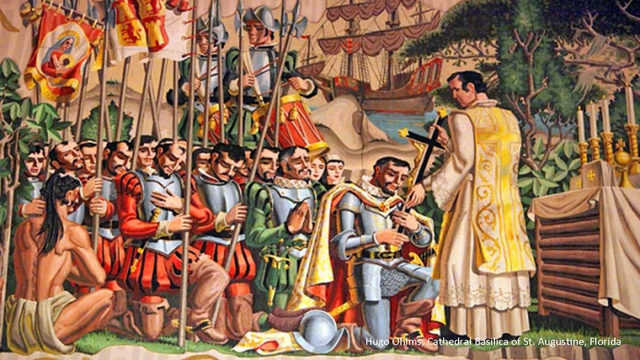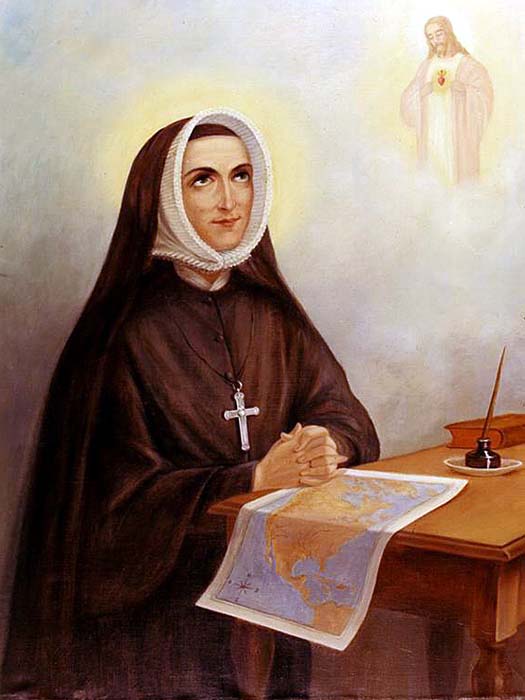
Today we we celebrate the feast of the Miraculous Medal and tomorrow we celebrate the memorial of St. Catherine Laboure. Born in 1806, Catherine’s birth name was Zoe Laboure.
She was the 9th child of eleven and was the only child in her family to not go to school and she didn’t learn to read and write. Her mother died when Zoé was 8, and when her elder sister, Louisa, left home to become a Sister of Charity, the duties of housekeeper and helper to her father fell upon her. From the time of her first Communion at Saint Remy, Catherine became a mystic. From the age of 14 or so, she heard the call to the religious life.
At age 18 Catherine had her first mystical experience. It was in the form of a dream of an old priest (who was a stranger to her,) that she assisted during a Mass in the dream. Four years later Catherine asked her father for permission to enter religious life. Her father flatly refused. A year later while in a visiting parlor of the Hospital de Saint-Sauveur in Chatillon, Catherine recognized the old priest from her dreams in a portrait of St. Vincent de Paul and knew God meant her to be a Sister of Charity. Her father finally allowed her to join the Sisters of Charity of St. Vincent de Paul in 1830. She took the name Catherine, and after her postulancy was sent to the convent in the Rue du Bac at Paris, where she arrived four days before the translation of the relics of St. Vincent from Notre-Dame to the Lazarist church.
On the eve of the Feast of Saint Vincent de Paul, July 19, the Superior spoke to the novices about the virtues of their Holy Founder and gave each of them a piece of cloth from his surplice. Catherine earnestly prayed to Saint Vincent that she might with her own eyes see the Mother of God.
She was convinced that she would see the Blessed Virgin Mary that very night; and in her conviction, Catherine fell asleep. Before long, she was awakened by a brilliant light and the voice of a child. "Sister Laboure, come to the Chapel; the Blessed Virgin awaits you." Catherine replied: "We shall be discovered."
The little child smiled, "Do not be uneasy; it is half past eleven, everyone is sleeping... come, I am waiting for you." She rose quickly and dressed. The hall lights were burning. The locked chapel door swung open at the angel's touch. Amazed, Catherine found the Chapel ablaze with lights as if prepared for midnight Mass. Quickly she knelt at the communion rail, and suddenly, she heard the rustle of a silk dress... the Blessed Virgin, in a blaze of glory, sat in the director's chair. The angel whispered: "The Blessed Mother wishes to speak with you."
Catherine rose, knelt beside the Blessed Mother and rested her hands in the Virgin's lap.
Our Lady told Catherine she would have to undertake a difficult task and also, it is said, spoke of the future and the violent death of an archbishop of Paris forty years later.
On November 27 Our Lady again appeared to Sister Catherine in the same chapel, in the form of a picture and as it were standing on a globe with shafts of light streaming from her hands towards it, surrounded by the words: "O Mary, conceived free from sin, pray for us who have recourse to thee!" Then the picture turned about, and sister Catherine saw on the reverse side a capital M, with a cross above it and two hearts, one crowned with thorns and the other pierced with a sword, below. And she seemed to herself to hear a voice telling her to have a medal struck representing these things, and promising that all who wore it with devotion should receive great graces by the intercession of the Mother of God. This or a similar vision was repeated in the following month and on several other occasions up to September 1831.
Sister Catherine confided in her confessor, and he, after making very careful investigations, was given permission by the archbishop of Paris, to have the medal struck. In June 1832 the first 1500 were issued. Originally called the “Medal of the Immaculate Conception”, it later became known to Catholics throughout the world as "miraculous".
The archbishop of Paris instituted a canonical inquiry into the alleged visions in 1836. The precautions she had taken to keep herself unknown, the promise she had wrung from her confessor not to tell anybody who she was, the secrecy she had kept towards everyone except her confessor, her constant unwillingness to appear before an ecclesiastical authority, account for this inquiry not being extended to the young sister herself. The tribunal decided in favor of the authenticity of the visions, taking into consideration the circumstances, the character of the sister concerned, and the prudent and level-headedness of her confessor.
The popularity of the medal increased daily, especially after the conversion of Alphonse Ratisbonne in 1842. He was a Jew who, having reluctantly agreed to wear the medal, and then consequently received a vision of our Lady in the church of Sant' Andrea delle Frate at Rome, whereupon he became a Christian and was later ordained a priest and became founder of a religious congregation, the Fathers and Sisters of Zion.
I met Zachary King in Wichita. He was a Baptist man who became a satanic high priest and through the miraculous medal. As a satanic high priest he assisted with and did abortions. However, one day someone gave him a miraculous medal and the moment he took it, he immediately had a vision of the Virgin Mary. At that moment, he gave up being a satanic follower and also knew he had to become Catholic. He became Catholic and since goes around giving talks throughout the United States warning people about the danger of the occult and satanism and also speaks about the power of the miraculous medal.
When I went on vacation to South Dakota a few years ago, as I was walking out of my motel room, a man was painting the exterior of the building. He walked up to me and said, “I used to be Catholic. I was invloved in witchcraft but don’t do it anymore. After some discussion, I invited him to return to the Church and go to confession. He said, “I will never go to confession. I don’t believe in it.” I handed him a miraculous medal and told him I would pray for him. He put it around his neck. The next day, when I returned to my motel, he walked up to me and said he wanted to return to Mass and said he wanted to go to confession. The power of miraculous medal is amazing. I have also seen how Our Lady uses the medal in parishes to bring back fallen away Catholics. So, if you know of anyone who is fallen away or who is not living a good lifestyle. Give them a miraculous medal and ask them to wear it. Its an innocent little medal, but Our Lady uses it in a powerful way.
This vision of Ratisbonne was also subject of a canonical inquiry and the reports of this were extensively used in the process of beatification of Catherine Labouré, of whose personal life very little is recorded. Her Superiors spoke of her as "rather insignificant", "matter-of-fact and unexcitable", "cold, almost apathetic".
From 1831 until her death on December 31, 1876, she lived unobtrusively among the community as portress, in charge of the poultry, and looking after the aged. Not until eight months before her death, did she speak to anyone except her confessor of the extraordinary graces she had received, and then she revealed them only to her superior. Her funeral was the occasion of an outburst of popular veneration, and a child of twelve, crippled from birth was instantaneously cured at her grave. St. Catherine Labouré was canonized in 1947, and Nov. 28th was appointed as her feast day. Today, her body is incorrupt is encased in glass.
When we think of the saints, we often forget that they were ordinary people, who lived extra ordinary lives, often times in a hidden way. Their lives were simple, yet profound.
I would like to close with a quote from St. Catherine on the subject of prayer. St. Catherine once said, "Whenever I go to the chapel, I put myself in the presence of our good Lord, and I say to him, Lord I am here. Tell me what you would have me to do. If He gives me some task, I am content and I thank him. If He gives me nothing, I still thank Him since I do not deserve to receive anything more than that. And then, I tell God everything that is in my heart. I tell him about my pains and joys, and then I listen. If you listen, God will also speak to you, for with the good Lord, you have to both speak and listen. God always speaks to you when you approach Him plainly and simply. "
Today may we strive to do as St. Catherine Laboure in prayer, to approach God plainly and simply, knowing if we speak to Him and if we listen, He will speak to us.











